The skills that every marketer needs to thrive in their role are expanding, thanks to new artificial intelligence (AI) technologies. To stay ahead, you not only need to be creative, strategic, analytical, and a good communicator, but you also need to be able to craft an effective AI prompt. AI is a powerful tool for marketers, essentially acting as a collaborator and thought partner that can augment and enhance a marketer’s existing skillset.
AI literacy is perhaps the most important new skill that every marketer needs to develop—and crafting an effective AI prompt is an essential part of it. Marketing teams cannot afford to be slow in this important upskilling if they want to retain top talent and win in today’s competitive market.
The content production process is one of the biggest pain points for marketing teams. It can often be long, slow, and difficult to scale. In fact, marketers spend 16 hours each week on creating materials, revising their work, and editing others’ materials—and that’s not including the additional 10 hours spent on other writing tasks each week.
But with generative AI, in particular, marketers say they have experienced increased productivity, more effective communication, and even enhanced creativity. AI’s ability to enhance every stage of the writing process is now the sharpest tool in a marketer’s toolbox—but only if they know how to use it.
In this article, we’re breaking down what makes a good AI prompt. Then we’re sharing specific AI prompt examples that marketing teams can use to scale high-quality content production.
What Makes an Effective AI Prompt?
It’s no secret: The better the prompt that you put in, the better the output the AI model produces. You wouldn’t ask a freelance marketer to write a blog on your behalf without giving them a detailed brief with goals, audience, expectations, and competitor information. Working with AI is no different.
But what exactly makes a great and effective AI prompt? Here are some specific techniques to help you craft better AI prompts:
- Be specific: The more precise your prompt, the better the AI will understand and respond. Specify the goal, topic, and any nuances of your content. For example, rather than asking for “tips on marketing,” frame your request as “What are five advanced SEO strategies for B2B technology companies?”
- Provide context: Whether it’s your audience, your channel, or even the time of year, this background information helps the AI deliver the most relevant and accurate output. For instance, “Generate a LinkedIn post targeting CFOs in the manufacturing sector about the benefits of our budget management software, highlighting that they need this before summer ends.”
- Clearly state the output you want: Specify the format you want the response in, whether it’s a list, a paragraph, bullet points, or a step-by-step guide. For example, “Give me a bulleted outline for a blog post on B2B influencer marketing.”
- Set constraints: If needed, set boundaries or guidelines. These could be word count, tone, or style guidelines. For instance, “Write me three email subject lines that are fewer than 10 words each and use a conversational tone.”
- Use examples: Direct the AI based on past examples of successful content. For example, if you already have social copy that is on-brand and performs well, feed it to the AI so that it can learn from what works. Make sure you use an enterprise AI tool that protects your data so that privacy remains paramount.
- Iterate and refine: AI improves with feedback and iteration. If the initial response isn’t exactly what you want, refine your prompt using the techniques above and try again. For instance, if the AI’s first attempt at a white paper outline lacks depth, ask for “A more detailed white paper outline addressing advanced cybersecurity challenges for B2B enterprises, with emphasis on solutions in the mobile workforce era.”
Note: We used these techniques ourselves to generate a first draft of the list above using Grammarly’s AI. Here’s what we asked: “Write me a bulleted list of what makes an effective AI prompt, provide specific examples for B2B marketing teams, and use Grammarly’s brand voice and tone.”
Now that you know what makes an effective prompt, let’s get into some specific examples that marketers can use for each stage of the writing process to boost their efficiency and output quality. For the purpose of this article, we’ll use the example of a content marketer at a B2B finance technology (FinTech) company writing an ebook on the benefits of automated accounting software.
Stage 1: Ideation
The first stage of the writing process is ideation or pre-writing, which consists of researching, brainstorming, and outlining. In this stage, you can use AI to generate fresh and relevant content ideas based on specific criteria, such as industry trends, the target audience, or the type of content you’re writing. The more specific the prompt, the more tailored and useful the AI-generated ideas will be.
AI prompt examples:
- Opening prompt: “What are the top three pain points that finance teams face when they don’t have automated accounting software?”
- Secondary prompt: “Use those pain points to generate a list of ebook title ideas that would capture the attention of finance managers and directors.”
- Tertiary prompt: “Turn that list and title into a three-chapter ebook outline, with each chapter focusing on a specific accounting team pain point.”
Pro tip: While AI is very powerful, sometimes it can lose its way when asked to generate long-form content in one fell swoop. Using a series of prompts is often more effective and helps you tune your output quickly and accurately.
Purpose: These prompts help marketers quickly perform research, brainstorm content ideas, and generate an outline tailored to their target audience. By specifying the industry, audience, and content format, the AI can provide relevant suggestions that save content marketers time in the ideation stage of writing.
With Grammarly, marketers can perform this ideation process wherever they write to unblock ideas and stay in a steady flow state. They simply prompt the AI to get ideas and outlines for ebooks, emails, articles, and more.
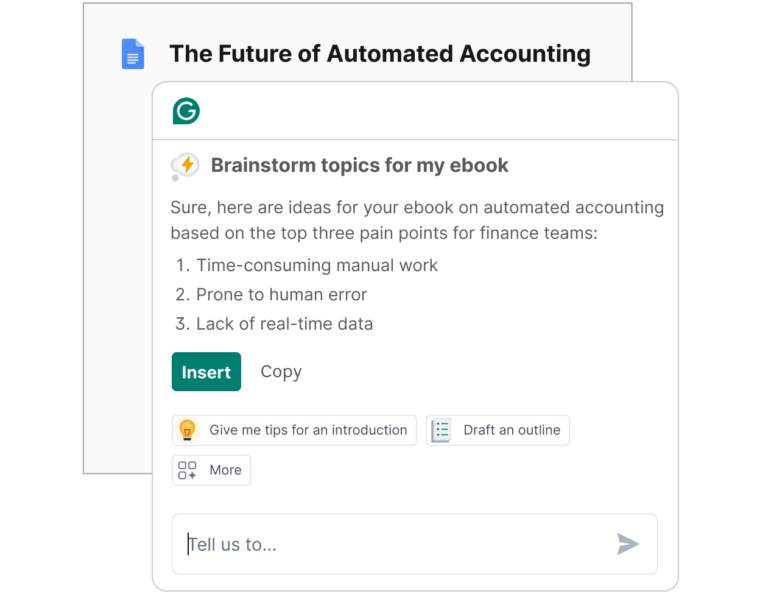
Stage 2: Composition
Once you have a list of ideas and a solid outline, the next stage is composition. This stage involves drafting the core content and is often the most time-consuming phase of writing.
AI can assist in this stage by writing engaging introductions, fleshing out specific chapters, or even generating entire drafts of the content based on the input provided. This can save time and help marketers overcome writer’s block, allowing them to focus on refining and enhancing the message.
AI prompt examples:
- “Draft an introduction for an ebook titled ‘The Future of Automated Accounting: Three Trends to Watch in 2024,’ based on the outline created above. Focus on creating an engaging hook that leans into the key pain points that finance directors face.”
- “Bolster this chapter with a specific example of a finance team that wastes time manually inputting accounting information. Pull the example from an existing case study, provided below [insert case study copy].”
- “Write a compelling conclusion with a call to action that drives readers to contact our sales team for more information.”
Pro tip: As a first step in the composition process, ask AI to generate an ebook with a simple prompt based on your topic. Use this output as a representation of C+ work and an example of what not to do. This generic output offers a good example of what all your competitors and existing content is already delivering, so it is now your job to include original thinking and strategic prompting to introduce a new A+ asset into the market.
Purpose: These prompts guide the AI to create the initial text that captures the reader’s attention. By specifying the title and desired tone, and providing contextual information like the case study, marketers can quickly generate a draft that sets the stage for the rest of the ebook.
With Grammarly, you can get ideas onto the page quickly and then organize and develop them into flawless, coherent writing. Each communication stage is unique, so just one AI model won’t do. Grammarly uses an ensemble of AI models and employs the best one for each stage of communication, so the outputs your team receives are comprehensive and specific to the writing done at work.
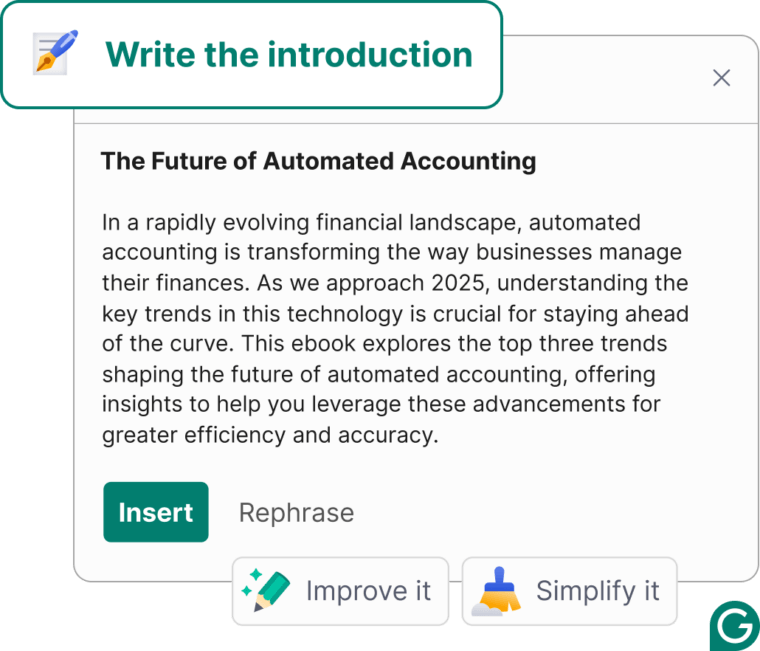
Stage 3: Editing and revisions
After the first draft is complete, the rewriting phase begins. This stage is all about refining the content, improving clarity, ensuring coherence, and making sure the messaging is as strong as possible. Rewriting often involves rephrasing sentences, restructuring paragraphs, and cutting unnecessary fluff.
AI tools can be particularly helpful in this phase by providing alternative phrasings, suggesting ways to simplify complex ideas, or enhancing the overall readability of the text. This ensures that the content is not only accurate but also engaging and easy to understand.
AI prompt examples:
- “Rephrase this paragraph to make it more concise and impactful.”
- “Highlight areas of this text that include unnecessary jargon or generalities.”
- “Rewrite the introduction to make the technical language more easily understandable to a non-CFO.”
- “Make this sound more on-brand with an emphasis on our warm and bold brand tones.”
Pro tip: During the editing process, most of what AI helps with are things that strong marketers are able to do already. The key value at this stage is efficiency. Many marketers are managing multiple projects and jumping between writing, reviewing, and publishing various pieces of content a day. AI is a powerful tool that helps marketers share the mental load as they consistently context switch between projects, audiences, and content formats.
Purpose: During the rewriting phase, these prompts help marketers refine their content, ensuring that it’s clear, concise, and resonates with their intended audience. When you use an in-line AI writing assistant like Grammarly, there is no need to copy and paste your text into another tab or AI tool.
Grammarly works wherever you write, so you don’t need to break your flow to enhance your writing. Plus, Grammarly’s AI tailors your writing to your brand’s unique voice, intended audience, and desired outcomes.
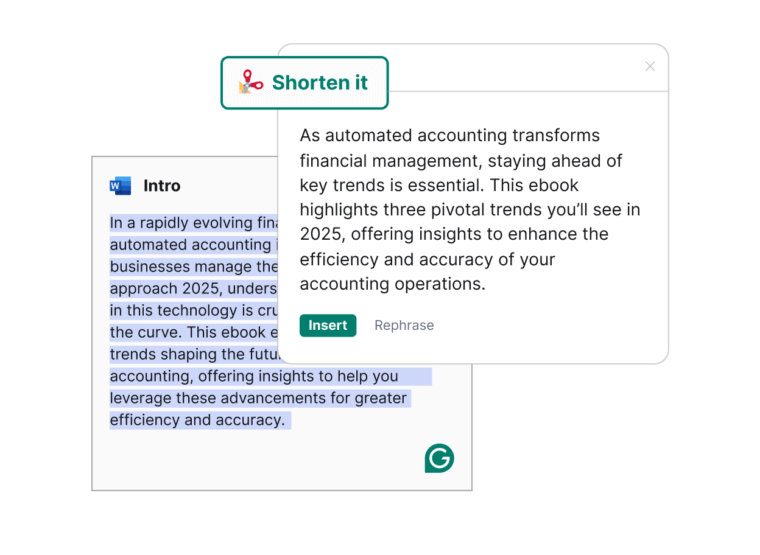
Stage 4: Personalization
Now comes the fun part: personalization. This is increasingly important in all marketing functions. In this stage, the goal is to adapt the content to resonate with your specific audience and to differentiate it for your unique brand. This involves altering the tone and aligning your messaging to your target audience.
AI can aid in personalization by helping to tailor content for different personas, industries, or channels. By adjusting the language, style, and tone of the content, marketers can ensure that their message speaks directly to their audience’s needs and preferences.
AI prompt examples:
- “Add a paragraph to the introduction that speaks directly to the IT persona and mentions the security benefits of our technology.”
- “Generate a LinkedIn post promoting this new ebook that targets CFOs at enterprise manufacturing companies.”
- “Update the conclusion to align with our new brand guidelines.”
Pro tip: You most likely have documents messaging positioning for each of your personas. Share this with your AI to help it further tailor its recommendations on how your company defines the pain points, benefits, and reasons to believe for each of your audience segments. But big caveat here: Ensure you understand how the AI you are using retains or trains on your data. You want to be certain that the AI tools and plan you are using does not use your proprietary information for public-facing model training. For instance, companies that use Grammarly’s Enterprise plan ensure none of their data will be compromised.
Purpose: Personalization is key to effective marketing. These prompts allow marketers to quickly and effectively tailor content to specific personas, industries, or company sizes, and make sure that their messaging aligns with company guidelines.
You can configure Grammarly’s AI to your brand tones so anyone on your team can generate great, on-brand writing at a moment’s notice. Grammarly’s AI writing assistance prompts you to make your main point stand out, include the right information in the most effective place, and tailor your writing to your audience.
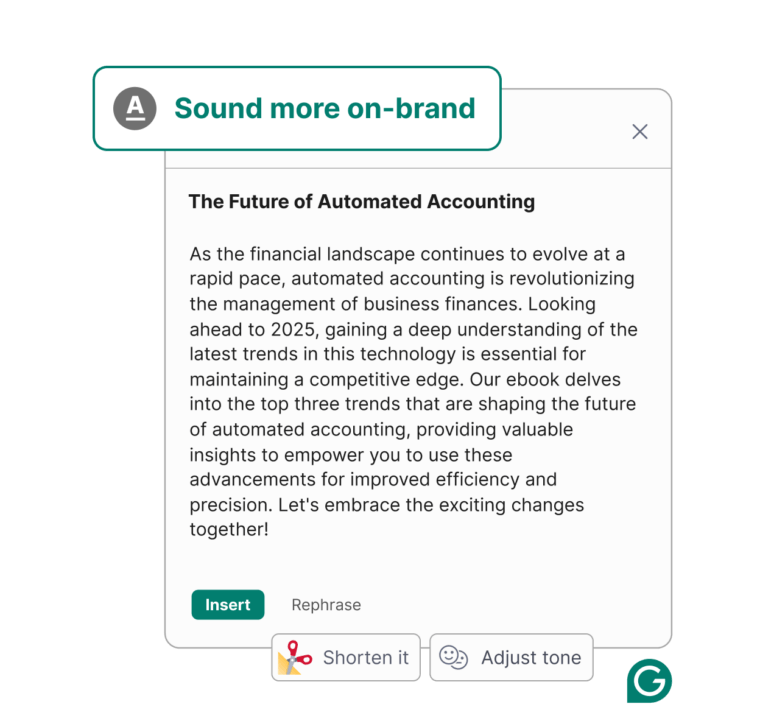
Stage 5: Proofreading
The final stage of the writing process is proofreading and editing. This is where you do a thorough review to catch any grammatical errors, typos, or inconsistencies. Proofreading is essential for maintaining your brand’s reputation and ensuring that the content is polished and ready for publication.
AI tools can streamline the proofreading process by quickly identifying and correcting errors. They should provide suggestions for improving sentence structure, tone, and overall readability, ensuring that the final piece is as strong as possible.
AI prompt examples:
- “Proofread this ebook post for grammar, punctuation, and clarity.”
- “Update any instances of passive voice to active voice.”
Pro tip: When you use an AI tool that automatically proofreads your text and suggests changes while you’re writing, you shouldn’t need to prompt the AI at all. That’s why investing in communication-focused AI tools is particularly relevant for marketers and other professional writers and communicators.
Purpose: Proofreading ensures that your content is polished and professional. These prompts instruct the AI to focus on correcting any grammatical or stylistic errors, providing a final check before publication.
When you’re using Grammarly’s AI writing assistance, these prompts aren’t even necessary. Grammarly’s AI is fine-tuned on effective business writing best practices, so it automatically proofreads your work, providing real-time feedback on grammar, punctuation, commonly confused words, and much more.
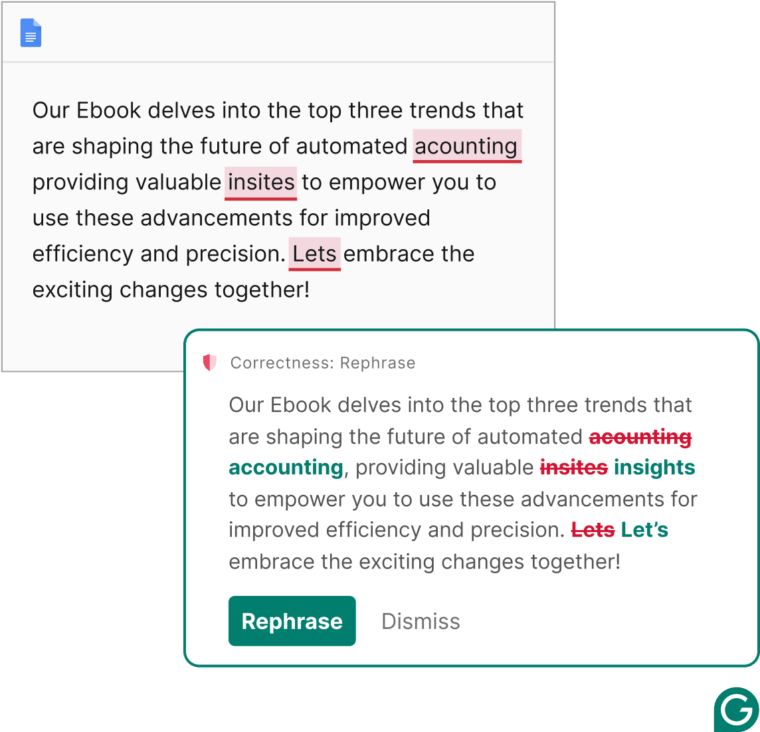
AI that understands your marketing goals
By strategically using these AI prompts at each stage of the writing process, your marketing can scale content production while maintaining your high bar for quality. These prompts not only save time but also ensure that all of your content is polished and personalized to your specific audiences. As AI continues to evolve, its role in content creation will only grow, offering even more opportunities to enhance your marketing efforts and augment your marketer’s skills.
Grammarly’s AI writing assistance helps marketing teams at enterprises like Eventbrite, Mitel, and Databricks scale their content production, write content that resonates, and cut editing time in half. Invest in secure AI that helps your team quickly publish clear, consistent marketing materials that maintain your brand’s standards. Get in touch with our team to learn more.



